Animated Stereotypes of
Africans & African Americans, Part I
As I begin this first clutch in a planned series reviews of vintage cartoons reliant on black stereotyping for their "humor," I have several goals in mind. First is to assess them as good or bad cartoons in their own right, judging them as fairly as I can apart from politicizing; but at the same time to assess their degree of insensitivity or racism.
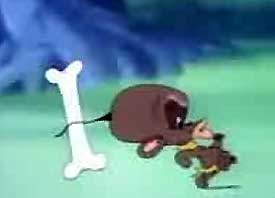 I disagree with the censoring & banning of cartoons on the basis of race stereotyping. And it is my feeling that several fine cartoons have been the babies thrown out with the bathwater due to rampaging censors or threatening activists. I disagree with the censoring & banning of cartoons on the basis of race stereotyping. And it is my feeling that several fine cartoons have been the babies thrown out with the bathwater due to rampaging censors or threatening activists.
Yet, if I were a black woman instead of a secular Jew, then some of these cartoons would leave me livid. The worst make me extremely uncomfortable. I doubt children of any race should be exposed to such malicious stuff.
I know it does make me awfully peevish when I see stereotypes of greedy crooked money-grubbing Jews, even if Eddy Cantor did it, even though by this time in history that's not the predominant stereotype against Jews.
So I'm striving for some balance here, & I'm sure those who despise all stereotyping of blacks will think my liking some of these cartoons is because I'm a honky who can afford to forgive too much.
And on the other end, a lot of my fellow honkies will deplore that I'm a feminist lefty who sees a strong streak of racism in some folks' favorite cartoons. Many have made the excuse that such cartoons are just as prone to poking fun with white stereotypes, & can get downright angry by any attempt to explain how there really is a difference.
Most cartoon fans today know perfectly well these cartoons are insensitive or racist & don't approve of them being so, but more strongly disapprove of the censorship. And to me that's extremely valid. We should be able to discuss the issues without having to ban the cartoons themselves.
Quite a number of these began down a road of severe suppression in response to the demands of activists two or three decades ago. They are still being suppressed today, either withheld from dvd distribution or television exhibition, or shown on cable in censorously edited versions only.
For this overview, let's start with Junior & George the bears, in their very last cartoon Half-Pint Pygmy (1948). They head off to pygmy country in Africa to find the world's smallest pygmy to sell for $10,000. The script reveals not the slightest clue that selling Africans for profit just might occasionally very possibly you-just-never-know be construed as slavery.
George & Junior find a miniature village & spot the smallest pygmy of the tribe, about the size of a hamster, thick-lipped lad with a bone through his hair.
They almost catch him with a watermelon trap, but he's way too clever for the bears. Several chase & escape gags follow one after another. The bears encounter an Asian tiger, Australian kangaroos, Arabic camel, as well as African animals during the chases.
The gags are trivial & cliche but it has a shaggy-dog-story pay-off at the end which was predictable but kinda funny even so.
The itty bitty pygmy getting the better of the would-be slavers makes him almost a heroic figure but the big lips caricatures with bone through hair is just so tiresome. Tex Avery has done so much better than this unfortunate film.
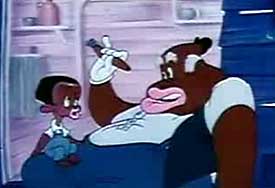 In Uncle Tom's Cabana (1947), some little black kids have gathered around a hugely overweight Kingfisher sort of guy (Kingfisher was a character from Amos & Andy show) with huge pink lips, such as we're supposed to accept as what black folks look like, though this image is much more akin to white folks doing blackface.
In Uncle Tom's Cabana (1947), some little black kids have gathered around a hugely overweight Kingfisher sort of guy (Kingfisher was a character from Amos & Andy show) with huge pink lips, such as we're supposed to accept as what black folks look like, though this image is much more akin to white folks doing blackface.
He begins to tell the kids the real & true story of Uncle Tom, who this Kingfisher guy claims personally to be. "This is the way it really happened. Once upon a time, in the big city..."
Simon Lee Gree is a scoundrelly Oil Can Harry property holder who owns the whole city except for Uncle Tom's Cabin, upon which he intends to foreclose so he'll own everything. If Tom can't pay by midnight, the last small building in the city will be taken away from him, so he calls Little Eva, played by that jitterbug gal Red, star also of a vastly better cartoon than this one, Red Hot Riding Hood (1943).
Red & Tom instantly turn the cabin into a nightclub, Uncle Tom's Cabana, & put on a show. The idea, in 1947, that a white woman & a black man could go into business together is radical & progressive, but nothing else in the film is.
Simon Lee Gree intends to blow up the cabana, but when he sees Little Eva singing "Old Virginy" he falls in love, duplicating the wolf-character's antics from Red Hot Riding Hood. At first she's dressed conservatively like Little Bo Peep, but then bursts into a jitterbug number.
The rather ridiculous story runs its course without much of interest happening. Then we're back with the kids who are being told the story. But Tom's gotten totally off the wall telling whoppers like how he threw the Empire State Building over the moon.
One of the kids asks, "Uncle Tom, is you sure all you been tellin' us is the truth?" He makes the mistake of saying if it ain't, "May lightning strike me dead." A mediocre cartoon over all not improved by its inessential race caricatures.
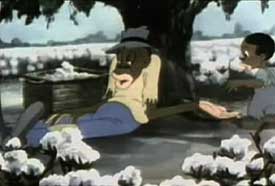 Spoofing Gone with the Wind (1939), the theatrically released Confederate Honey (1940) stars Elmer Fudd as Nett Cutler, for whom Crimson O'Hairoil has developed an inexplicable crush & hopes he will ask her to marry. But the Civil War begins & off he goes, returning long afer war's end to finish their pre-war conversation, which will be a disappointment to Crimson.
Spoofing Gone with the Wind (1939), the theatrically released Confederate Honey (1940) stars Elmer Fudd as Nett Cutler, for whom Crimson O'Hairoil has developed an inexplicable crush & hopes he will ask her to marry. But the Civil War begins & off he goes, returning long afer war's end to finish their pre-war conversation, which will be a disappointment to Crimson.
As a send-up of Rhett Butler & Scarlet O'Hara, these characters have almost no touchstones with the movie, & not terribly interesting for this component. What ends up being the most obvious aspect of the film is its reliance on demeaning stereotypes of black folks in slave days.
After an intruduction to the blue-blooded (& blue-skinned) plantation owner, the camera scans right to "Uncle Tom's Bungalows" rentable for $1.50 per night & up. These look like run down horse barns, a joke on slave quarters that's not the least funny.
The soundtrack's harmony group is singing "Gone are the days when my heart was young & gay/ Gone are my friends from the cotton fields away." To this tune, a series of monkey-like darkies are shown slaving joyfully amidst the cotton.
When you look at the content of some of the famed "banned eleven" cartoons, you realize that some of them are authentic works of art & the censorship a lot more evil than whatever stereotypes they contain. Confederate Honey, however, in just a couple of scenes, has established itself in script, design, & execution as the work of ignorance & malice disguising itself as humor.
But rather than ban it, it should've been made available as an example of exactly its style of malicious insensitivity void of humor. And the fact that censors couldn't tell the difference between this horrible cartoon & an awesome one like Tin Pan Alley Cats (1943) or Li'l Old Bosko & the Pirates (1937) is only proof that censors should not be so empowered.
As the malice continues, we see an ultra-lazy darkie slave moving in slow motion to gather one cotton ball. None of these characters look particularly human & if not monkeys, then they're white men in black face & big white wax lips.
Finally we're introduced to the plantation-owning colonel's daughter, Crimson O'Hairoil, with a silver spoon in her mouth, literally, & a female of that monkey species on its knees serving her feet.
The war between the north & south breaks out & Crimson's boyfriend Ned heads off for war. There follows some images of modern warfare mixed with Union & Confederate uniforms, without even one funny bit arising.
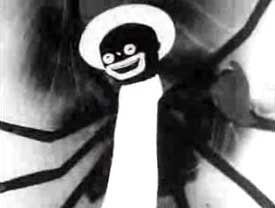 Spider & Tulip (Kumo-to-Churippu, 1943) is a b/w cartoon from Japan. It features a villainous spider who is after a gentle ladybug who sings with a little girl's voice. The cell animation is done over photographs of actual flowers & garden scenes.
Spider & Tulip (Kumo-to-Churippu, 1943) is a b/w cartoon from Japan. It features a villainous spider who is after a gentle ladybug who sings with a little girl's voice. The cell animation is done over photographs of actual flowers & garden scenes.
Much of this short film is so wonderful & imaginative that it comes close to being a masterpiece. But it is strongly inspired by American animators of the era, resulting in the spider unfortunately depicted as an black-face stereotype drawn straight from racially insensitive American cartoons that arose, whether or not innocently, in a racist context.
The spider makes a poor villain because of his enormous smile & minstrel-show mannerisms, which may be stereotyped but are not villainous. He sings to attract his victims. He's such a jolly guy, you kind of want to like him.
However, he does want to eat a child ladybug, to whom he sings seductively. If this were real "nature" in any of it, of course, the ultra-innocent ladybug would be eating baby aphids so from someone's point of view just as mean as the spider.
When the spider is his most menacing, a tulip cries out to the ladybug to take refuge inside her closed petals. The frustrated spider spins a cocoon around the entire flower, then goes back to his main web to relight his pipe & take a nap in his webby hammock.
A storm arises in the moonlight. The spider's web is blown to bits. As the spider tries to hold on to his home, he's blown through the garden & killed in a pond.
Morning sun dries out the flowers. A fly comes by & helps get the spun webs off the tulip, liberating little ladybug, as the flower-spirit opens her petals & stands boldly in the light.
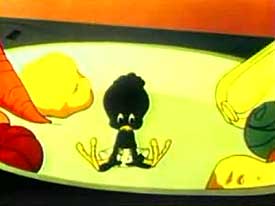 Flop Goes the Weasel (1943) has been suppressed from television play for its race caricatures. These particular caricatures, however, would not offend any but the most die-hard soul eager to feel oppressed. It perhaps rises to the level of politically incorrect, but certainly never merited being censored from public viewing.
Flop Goes the Weasel (1943) has been suppressed from television play for its race caricatures. These particular caricatures, however, would not offend any but the most die-hard soul eager to feel oppressed. It perhaps rises to the level of politically incorrect, but certainly never merited being censored from public viewing.
A black hen, brooding on her eggs & knitting, is wearing an Aunt Jemima headscarf, & sings a beautiful tune about mammy's love. A political analysis of the recurring Mammy figure & Aunt Jamima can be illuminating, & it certainly can be a burdensome stereotype. But come on, suppress a cartoon because of a chicken's red bandana?
She's got one egg she addresses as Junior & Honey Chile. While she's out looking for a worm so he can eat the instant he hatches, the weasel arrives, having a recipe on hand that requires one fresh egg.
Back in the weasel's lair, when he tries to make his egg dish, a fully developed & fast-talking black chick plops out & greats the weasel as his mammy. Cute though the weasel finds this little chick, he even so wants to eat him.
Junior is given no racially exaggerated features, he's just a regular black chicken intentionally evoking a black child, or just any child. Full of curiosity about the world, Junior asks, "What kinda animals is we, mammy? Is we horses *whinney* or is we hyenas *haha-haha*?"
"Hyuk hyuk hyuk lo'd have mercy," answers the weasel, having put on an Aunt Jemima bandana to impersonate Junior's mom. "No honey chile, we all is weasels."
The rest of the cartoon is the little-boy chick playing games with the weasel who is secretly trying to make the chick into a meal. By cleverness & good humor, the baby chicken can't be harmed.
By the time Mammy Hen returns to her nest with worms that she calls "viddels for my little black rosebud," Junior's already home, having known all along that the weasel wanted to eat him, having defeated the weasel & gotten himself home safely. "I fooled him mammy! I fooled him good!"
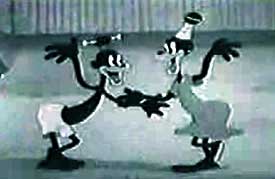 Porky is on a safari in Darkest Africa in another suppressed cartoon Africa Squeaks (1932). An edited version that attempts to do away with the worst of the numerous racist caricatures has been seen on cable. A poor but complete copy is available on a dvd compilation of racist cartoons.
Porky is on a safari in Darkest Africa in another suppressed cartoon Africa Squeaks (1932). An edited version that attempts to do away with the worst of the numerous racist caricatures has been seen on cable. A poor but complete copy is available on a dvd compilation of racist cartoons.
The b/w animation shows several African animal gags. Among African beasts are the California giant condor & Australia's kangaroos. The three commando Bambi deer are perhaps the best gag.
Porky Pig leads a row of black jungle porters who barely register as characters at all. When the tale introduces "individual" natives it's done as though they're the same as the animals, the homonid gag pretty similiar to the lions & the monkeys gag.
A thick-lipped African with bone through his hair uses his blowgun to win a ham from a carnie who talks like Rochester. Later, a little black sambo style character appears, about Porky's size, the usual big lips but no bone through hair this time, trying to tell him about a white man living in the Jungle.
As there's been an ongoing gag about Stanley searching for "Dr. Livingston, I presume," Porky grabs the Spencer Tracy caricature & takes him to the village where the white man is staying. But the white guy turns out to be the band leader "Cake Icer" with his Kollege of Musical Knowlege. He addresses the native black people as "elephants & giraffs" ending with a musical jive party of animals & black people. There's not a hint of irony of this cartoon's assumption that negroes are more animal than human.
Our last image is of a map of the continent of Africa that bursts forth with blackface features that say good-bye. This is a cartoon that doubtless delighted children in its day & still would. But if the barrage of such imagery was still permitted it predominate where children watch cartoons, this could certainly be damaging, the more so to black children.
Of that there is small doubt, but rather than this being the justification for censorship, it should rather be justification for package warnings of racist content, or televised only very late when children are in bed. Outright suppression is not the decent response.
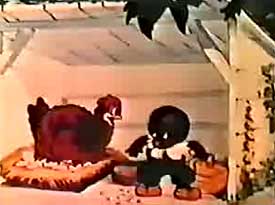 A lot of these cartoons reliant on African American stereotypes & bone-through-hair Black Sambos just aren't funny, not even on their own level. But the later technicolor "Little Ol' Bosko" cartoons tend to be awfully good, perhaps in part because Bosko & his little girlfriend Honey are closer to being universal children rather than racist caricatures.
A lot of these cartoons reliant on African American stereotypes & bone-through-hair Black Sambos just aren't funny, not even on their own level. But the later technicolor "Little Ol' Bosko" cartoons tend to be awfully good, perhaps in part because Bosko & his little girlfriend Honey are closer to being universal children rather than racist caricatures.
But some of the Bosko cartoons are more offending than others. Bosko's Easter Eggs (1937) is reliant on a very old stereotype about black people being chicken thieves.
Stealing chickens or their eggs & sneaking into watermelon patches to steal watermelons has been used in the cinema as natural behaviors for black folks since the earliest days of the silent era; for examples see my review of The Watermelon Patch which also plays off the cliche of blacks being ultra-scared of ghosts.
Bosko's taking Honey some easter eggs, rapping a rhyme as he goes. His voice is older than in the other technicolor Bosko episodes, so perhaps he's growing up. Honey meanwhile is trying to get her red hen to hatch some easter eggs in order to hatch some easter chicks.
After Honey wanders off, Bosko's dog Bruno gets in a fight with Honey's hen. Bruno gets bested & runs away smack into Bosko causing him to break his basket of easter eggs. In consequence he wants to replace them with the eggs Honey's hen is setting on & sets out to steal his girlfriend's eggs.
Honey catches Bosko & Bruno stealing. She makes them put them back, & while the hen is away, Bruno has to sit on the eggs keeping them warm.
The hen ends up terrorizing Bosko & Bruno & the antics are pretty silly but it's definitely not a great cartoon. The lame climax is the chicks hatch. But see my reviews of the "jazz frog cartoons" for the really good Boskos, which episodes rely on Bosko being a very small child of limitless imagination.
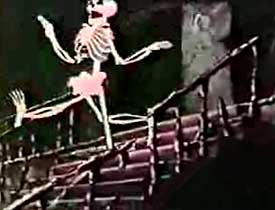 Bosko & Honey, the two black children, & the dog Bruno, visit a haunted house in another technicolor episode The Old House (1936). Because this version of Bosko & Honey presents them as somewhat realistic as children, it would not be at all offending if hundreds of films hadn't already shown black characters this afraid of ghosts that don't exist.
Bosko & Honey, the two black children, & the dog Bruno, visit a haunted house in another technicolor episode The Old House (1936). Because this version of Bosko & Honey presents them as somewhat realistic as children, it would not be at all offending if hundreds of films hadn't already shown black characters this afraid of ghosts that don't exist.
If assessed apart from its social context, this isn't a bad cartoon at all, but of course, we're not aliens from another planet & The Old House does exist in a social context.
There's an allegedly haunted house along the path to grandma's house. Bosko's scared to go past it, but Honey sings: "I ain't 'fraid of spooks because/ There ain't no spooks nowhere/ Goblins never bothered me/ Because they were not there."
Honey sets out in a storm to prove she's never scared, & takes refuge in the supposedly haunted house. She nervously sings, "If someday I meet a ghost/ I bet he gets scared the most." But between the bats & strange noises, she's soon running about scared & screaming.
Bosko comes running to the sound of her cries, intent on rescuing her from ghosts. In the dark with shadows & sounds, Bosko's soon enough scared, though there've been no ghosts at all. But Bosko gets caught under a sheet & Honey gets stuck in a moosehead & both think the other's a ghost.
As they scream their little heads off, the dog breaks loose from his chain & rushes to the aid of the kids. He, too, is soon scared. The nonstop silliness continues, & if this were as stereotypical as cartoons ever got, there'd be a lot less to complain about.
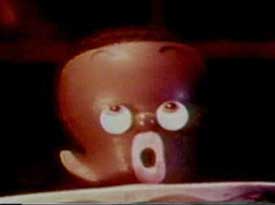 George Pal Puppetoons were among the highest quality cartoons of their era, & Jasper one of his most beloved characters. When I was a kid I'd occasionally see Jasper episodes on shows with names like "Cartoon Carnival" which showed a local station's in-house collection of animation.
George Pal Puppetoons were among the highest quality cartoons of their era, & Jasper one of his most beloved characters. When I was a kid I'd occasionally see Jasper episodes on shows with names like "Cartoon Carnival" which showed a local station's in-house collection of animation.
I was too little to have any concept of racism & all I saw was a child having adventures, & Jasper seemed like any child to me. But adult perceptions will catch stereotypes that should've been an embarrassment even in the 1940s, & in the post Civil Rights era, Jasper's fall from grace was absolute, & these little films were thereafter rarely shown anywhere.
The beautiful color-pallets & the three dimensionallity of the well-designed puppets have aesthetic appeal. As characters move through their miniature landscapes, they are ultra-charming.
Jasper & the Haunted House (1942) opens on a meadow with a scarecrow under a tree. The scarecrow lifts its head -- he's a black guy with stovepipe hat & a friendly crow upon one shoulder. He smells a gooseberry pie & asks the crow, "Mmm mmm, what's that fumigatin' the atmosphere?"
It's Jasper walking along to Deacon Jones' house with a fresh-baked gooseberry pie his momma made. When the scarecrow says, "Hey boy," Jasper's eyes bug out. The scarecrow tricks Jasper into delivering the pie not to the Deacon's house, but to a notorious haunted house.
The miniature models are just so amazing, & the haunted house is a truly eerie atmospheric place with great detail. Jasper finds himself locked in the house, his knees knocking, pursued by shadows.
Scarecrow & Blackbird think they've got the pie now, but a ghost gets it instead. Jasper, Blackbird & Scarecrow hide in the upright piano, & the ghost sits down to play some boogy-woogy on it. Various furnishings in the house are dancing while the scared ones in the piano get beaten up by the piano's little hammers.
The stereotype of the bug-eyed negro scared of haints understandably offended a percentage of the African American community, though to child viewers this wasn't about a superstitious black man, it was about a child like any child afraid of the dark. Some Jasper episodes were truly offending in their reliance on stereotype, but this one requires considerable analysis to find the offense.
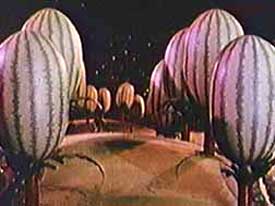 Scarecrow tells Jasper about a place where the roads are paved with watermelons, "and the trees, they ain't ordinary trees, they's big watermelons." Jasper is just beside himself with desire for watermelon, in the simultaneously charming & racist puppet-tune Jasper & the Watermelons (1942).
Scarecrow tells Jasper about a place where the roads are paved with watermelons, "and the trees, they ain't ordinary trees, they's big watermelons." Jasper is just beside himself with desire for watermelon, in the simultaneously charming & racist puppet-tune Jasper & the Watermelons (1942).
As the Scarecrow weaves his tale, he & Jasper are transported to Watermelonland, which at first is a glorious-seeming place, with everything made of watermelons.
But when Jasper dares to eat of the watermelons of this country, the sky goes black, the watermelons reveal horrific visages, & they sing, "Gonna be trouble in watermelonland tonight!"
Terrified Jasper runs home to his mammy as fast as his little feet can carry him. When he reaches home, he's alarmed to discover his mother has prepared for him a feast of -- watermelon.
This was the first Little Jasper cartoon & one of the best. It's quality of production was praised immediately upon its release, & just about anyone would have to admit it's visually stunning.
But as each new Jasper cartoon more & more deeply perpetuated "the misconceptions of Negro characteristics" (as noted by Sondra Gorney in Hollywood Quarterly toward the end of Jasper's film career), George Pal must've realized he'd made a horrible mistake.
Pal also made John Henry & the Inky-poo (1946), one of the greatest cartoons of all time, with an adult male hero who was black. Pal loved African American folklore which inspired the John Henry cartoon, & he loved Black jazz performers whose music he adapted to his cartoons. So he was not eager to admit his Jasper cartoons were racist, & was reportedly deeply offended by the criticism.
Pal's personal sense of being innocent of racism doesn't speak well of his intellect. If I made jokes about inbred honky rednecks in trailer parks, hook-nosed Jews pinching pennies & selling rags, or bucktooth thick-glasses Japanese saying "Solly Cholly" as they bomb Pearl Harbor, I'd sure as hell know someone would be offended.
And if I had the attitude "Fuck them, I think it's funny," then that's on me; cuz maybe it is funny, just like Little Jasper cartoons have admitted cuteness to them. But seriously, how is possible George Pal was so profoundly ignorant as to be surprised & hurt that anyone could be offended by representations of a black kid living in a shack with his "mammy"; whose eyes bug out at the thought of ghosts or who dreams of a journey to Watermelon land.
I think an awfully large argument can be made in favor of Little Jasper, who wouldn't be offensive in a world that wasn't racist.
But when you add George Pal's deep level of unawareness, & his belief that coopting black culture for his own art should've made him beloved among black people, well, he wouldn't've gotten in any trouble if he'd had the common sense to find black writers to help him around the pitfalls that betray prejudices whenever white folks decide black experience is their own to represent.
These are great cartoons but they just might have contributed something grander to the culture if Pal hadn't thought he knew everything anyone needed to know to portray African American boyhood.
Instead, he came up with scripts that required embracing stereotypes. Watermelonland wouldn't make a lot of sense if the story was about a white boy. And the reason it wouldn't make a lot of sense is because it plays exclusively to white stereotyping of blacks. And even that ripe old honky Mark Twain would've been offended.
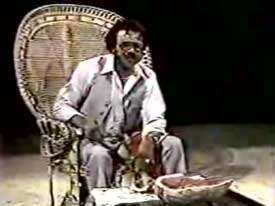 Petey Greene's six-minute instructional film on how to eat watermelon is Be Yourself (1982), which you should be able to find on youtube, ifilm, & a score other locations on the web.
Petey Greene's six-minute instructional film on how to eat watermelon is Be Yourself (1982), which you should be able to find on youtube, ifilm, & a score other locations on the web.
It has come to be better known as How to Eat a Watermelon, & it's an absolutely stunning comedy bit that also serves as a commentary on black sensitivity to such stereotypes as assault their community daily.
It's disturbingly funny as he sloppily chows down on a slice of watermelon while lecturing black viewers to "be yourself" & stop being all weird about not wanting to be seen eating watermelons with a proper abandon.
Greene was an ex-con & Black Panther civil rights activist who became a Washington, D.C. radio & public access television personality doing radical humor, radical thought, & radical truth, with a proud ghetto aggressiveness.
If this routine is an example of his in-your-face lecturiness, then this dude was cool. And Don Cheadle recreates his personality in the docudrama Talk To Me (2007).
copyright © by Paghat the Ratgirl
|
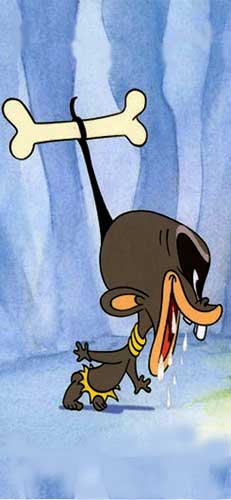
 I disagree with the censoring & banning of cartoons on the basis of race stereotyping. And it is my feeling that several fine cartoons have been the babies thrown out with the bathwater due to rampaging censors or threatening activists.
I disagree with the censoring & banning of cartoons on the basis of race stereotyping. And it is my feeling that several fine cartoons have been the babies thrown out with the bathwater due to rampaging censors or threatening activists.








